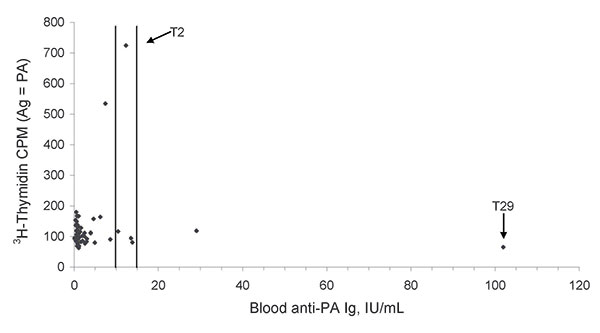Volume 15, Number 10—October 2009
Dispatch
Immunologic Response of Unvaccinated Workers Exposed to Anthrax, Belgium
Figure 2

Figure 2. Graph showing anti–protective antigen (PA) immunoglobulin G (IgG) titers plotted against 3H-thymidine counts per minute (cpm) derived from PA-stimulated blood cell cultures conducted in year 2. The vertical lines define the ELISA borderline and upper thresholds (10 IU/mL and 15 IU/mL, respectively), which were defined as PA titers by the ELISA kit manufacturer, i.e., titers supposed to confer protection after vaccination. Samples testing below the borderline threshold are considered negative. T29 and T2 refer to workers whose samples had a remarkably high antibody titer or lymphocyte proliferation count, respectively.
Page created: December 09, 2010
Page updated: December 09, 2010
Page reviewed: December 09, 2010
The conclusions, findings, and opinions expressed by authors contributing to this journal do not necessarily reflect the official position of the U.S. Department of Health and Human Services, the Public Health Service, the Centers for Disease Control and Prevention, or the authors' affiliated institutions. Use of trade names is for identification only and does not imply endorsement by any of the groups named above.